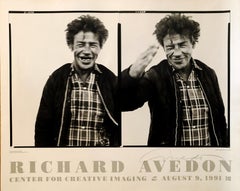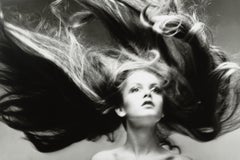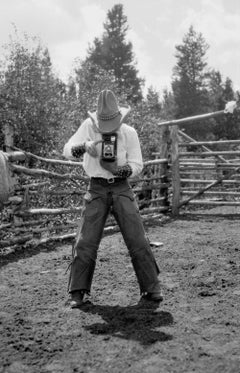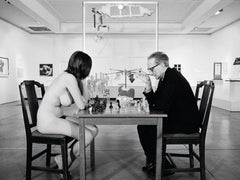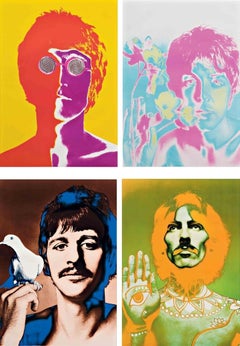Richard Avedon Portrait Photography
A while back, Richard Avedon had a confession to make. “I hate cameras,” said the man who revolutionized fashion and portrait photography. “If I could only work with my eyes alone!”
Yet Avedon’s photos seem to do just that — they remove the distance the camera lens creates to make you feel that you are right there beside his subjects.
Born in New York City in 1923, Avedon had a stern father, an artistic mother and a beautiful, but troubled, sister. At 18, he wanted to be a poet. And the slight, 5’7” dreamer didn’t lack confidence — or a sense of drama. “I know my drifting will not prove a loss / For mine is a rolling stone that has gathered moss,” he wrote in 1941.
A year later, Avedon joined the Merchant Marines, where he spent his World War II years shooting ID photos of new recruits. “I must have taken pictures of 100,000 faces before it occurred to me I was becoming a photographer,” he later recalled.
After demobilization in 1944, Avedon shot fashion pictures for the tony Manhattan department store Bonwit Teller and studied with Alexey Brodovitch, the legendary art director of Harper’s Bazaar. By 1945, his work was appearing in Junior Bazaar.
“His first photographs for us were technically very bad,” Brodovitch later recalled. “But they were not snapshots. . . . Those first pictures of his had freshness and individuality, and they showed enthusiasm and a willingness to take chances.”
Who else was willing to take chances? Brodovitch and Carmel Snow, editor in chief of Harper’s Bazaar, who soon sent the young talent to fashion’s sacred capital, Paris.
The postwar years were hard in Paris. When Avedon first arrived there, in 1946, it was with an explicit directive from Snow. “Dick was tasked with this idea that he was there to rebuild Paris,” explains Martin. In restoring the energy and excitement around Paris, Avedon imbued it with some of his own.
Avedon’s models jumped, twirled, leapt over puddles and they smiled. Like Avedon himself, they rarely stood still. While he wasn’t the first to use action in fashion photography (in the 1930s, Martin Munkacsi and Toni Frissell began creating fashion images of women engaged in sporty scenarios), Avedon was the first to pair such vitality with women wearing couture.
Character and spirit became la mode. Dovima’s graceful silhouette juxtaposed against the wrinkled heft of two shackled elephants. Dorian Leigh laughing and embracing a bicycle racer. Suzy Parker roller skating across the Place de la Concorde. Sunny Harnett and her cool gaze just daring the roulette table — and every man in the room — not to do her bidding. There was always a narrative in an Avedon mise en scène — whether the background was elaborately staged or stark, the model’s job had forever changed from posing, to acting.
Of course, Avedon did not limit himself to fashion photography. The little boy who once collected autographs grew up to create the most iconic portraits of the 20th century, many of these were included in an exhibition at Guild Hall Museum in East Hampton, New York, in 2017.
A 1958 New Yorker profile noted that even though Avedon’s portraits immortalized cultural elites such as Truman Capote, Elsa Maxwell and Charles Laughton, the qualities that most interested the photographer were “advanced age, physical debility, ugliness, or the pathos underlying the surface insouciance.” Yet “none of Avedon’s subjects seem to resent this kind of treatment . . . being selected to sit for one of his Harper’s Bazaar portraits ranks as an accolade.”
Over the next 40-plus years of his career, his iconic portraiture never lost its force; although at times, his unvarnished truth felt cruel.
But Avedon was a creator, not an observer, and he made no apologies for this. The sitter and the photographer “have separate ambitions for the image,” he wrote in 1985. “His need to plead his case probably goes as deep as my need to plead mine, but the control is with me.”
Find original Richard Avedon photography on 1stDibs.
1990s Richard Avedon Portrait Photography
Offset
1960s Richard Avedon Portrait Photography
Silver Gelatin
1920s Other Art Style Richard Avedon Portrait Photography
Silver Gelatin
1960s Richard Avedon Portrait Photography
Photographic Paper, Silver Gelatin
1950s Richard Avedon Portrait Photography
Photographic Film, Photographic Paper, Silver Gelatin
2010s Pop Art Richard Avedon Portrait Photography
Archival Paper, Lithograph, Offset
Early 2000s Contemporary Richard Avedon Portrait Photography
Silver Gelatin
1960s Contemporary Richard Avedon Portrait Photography
Offset
1940s Other Art Style Richard Avedon Portrait Photography
Silver Gelatin
1970s Realist Richard Avedon Portrait Photography
Offset
Early 2000s Conceptual Richard Avedon Portrait Photography
Silver Gelatin
Early 2000s Conceptual Richard Avedon Portrait Photography
Silver Gelatin
1980s Young British Artists (YBA) Richard Avedon Portrait Photography
Silver Gelatin
Early 2000s Pop Art Richard Avedon Portrait Photography
Lithograph, Offset, Mixed Media
1960s Contemporary Richard Avedon Portrait Photography
Lithograph
1960s Contemporary Richard Avedon Portrait Photography
Lithograph
1970s American Modern Richard Avedon Portrait Photography
Silver Gelatin
1970s American Modern Richard Avedon Portrait Photography
Silver Gelatin
1990s 85 New Wave Richard Avedon Portrait Photography
1950s Modern Richard Avedon Portrait Photography
1960s American Realist Richard Avedon Portrait Photography
Silver Gelatin
1950s Richard Avedon Portrait Photography
1960s Richard Avedon Portrait Photography
Richard Avedon portrait photography for sale on 1stDibs.
Artists Similar to Richard Avedon
- 1stDibs ExpertJanuary 19, 2025Opinions may vary on what is the most famous Richard Avedon photo. One contender is Ronald Fischer, Beekeeper, Davis, California from the photographer's In the American West series, and another is the 1959 portrait of Brigitte Bardot for Harper's Bazaar. Other famous photographs by Avedon include Dovima with the Elephants, The Family, his 1957 portrait of Marilyn Monroe and his 1967 photograph of The Beatles. On 1stDibs, explore an assortment of Richard Avedon photography.
